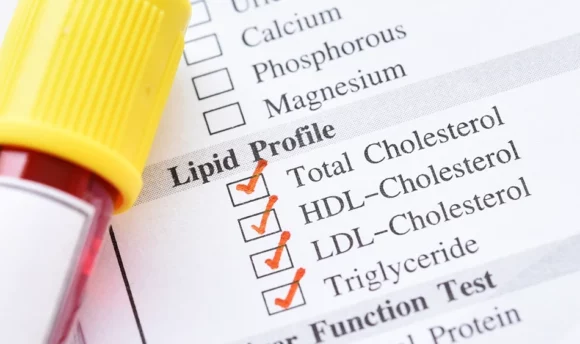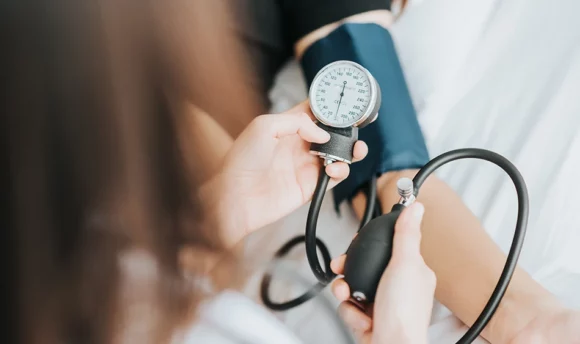High Cholesterol Symptoms in the Eyes: 4 Common Signs
Noticing sudden changes in your vision can be alarming, especially if you suffer from high cholesterol levels. What is the link between these two aspects? We explain the 4 common signs of cholesterol damage in the eyes and how you could protect your vision.

One day, you might see eye floaters and pay no attention. These floaters are normal for most people, but if you experience them regularly, this could be a sign of something else.
High cholesterol levels can produce many physical symptoms. Some of these symptoms revolve around your eyes. You could see moving spots or struggle to see things properly in the distance. If this is something that happens often, your cholesterol may be the culprit.
You might be thinking – is this damage going to be long-term? Are there ways I can stop this from happening in the future?
To get answers to those questions, keep reading our article about the 4 common signs of high cholesterol in your eyes.
4 High Cholesterol Symptoms in the Eyes
#1 Blurry vision
#2 Yellow bumps around the eyes
#3 White, gray, or yellow deposits around the cornea
#4 Eye floaters
4 High Cholesterol Symptoms in the Eyes You Should Be Aware of
People who struggle to maintain their cholesterol may notice ocular symptoms. This isn’t always serious, but it’s a sign you should lower your cholesterol levels. It can be scary to deal with when you don’t quite understand the cause, but there are ways to pick up on the signs.
Let’s take a look at the 4 common symptoms of high cholesterol in the eyes:
#1 Blurry vision
A retinal vein occlusion is a serious condition that causes blurry vision. This happens when high cholesterol levels (LDL) clot the blood in narrow veins. The first sign of a blockage is the blurry focus in just one eye or complete loss of vision that worsens over the next few hours or days.
People who experience regular problems with their blood flow are at a higher risk of developing this symptom. For example, someone who suffers from high blood pressure (hypertension) could also have narrow veins in their eyes, depending on how they manage the condition.
Those with high blood pressure can feel tired, leading to a weakened body. This may especially target the eyes and damage blood vessels in your retina. It’s very important that you seek professional help right away to avoid permanent damage and long-term vision loss.
#2 Yellow bumps around the eyes
Raised yellow bumps around your eyes may be a sign of xanthelasma palpebrarum (XP). This health condition refers to a high amount of bad cholesterol that forms harmless growths. The non-painful fatty deposits usually appear yellow and sit on your upper and lower eyelids.
You can get a doctor to remove these, but they might indicate an underlying issue. Having more lumps could represent early heart disease. Now, this sounds quite daunting, but there are ways to control cholesterol deposits and prevent heart attack and stroke risk.
To prevent those yellow bumps, eat a low-salt diet, drink more water, and manage stress levels. Anxiety spikes blood pressure and increases cholesterol content in your body. If you notice any bumps, find ways to lower cholesterol levels and speak to your doctor about surgery options.
#3 White, gray, or yellow deposits around the cornea
Arcus senilis is the main reason for yellow, white, or gray deposits around the cornea. These deposits appear as thin circles that have a sharp inner border. However, this symptom doesn’t affect your vision, but you can’t get rid of the colored circles or find treatment to remove them.
Deposits only happen when your cholesterol levels are too high. This is common in older adults who may not have control over the lipid content in their bodies. More lipids (types of fat) can build up deep in the cornea’s edge and eventually form a complete ring around your iris.
Some people might not be bothered about the deposits, but there are still ways to prevent them. You could go for a long-distance run or consume less alcohol to maintain high-density lipoprotein (the good cholesterol) in your body.
#4 Eye floaters
Many people experience those annoying eye floaters, even when they’re perfectly healthy. Your eyes go through normal changes that cause strands of gel-like liquid to stick together. This casts a shadow on your retina, which looks like floating particles are swimming around.
However, eye floaters can be one of the warning signs of high cholesterol. Damaged blood vessels usually create those floaters that circulate in your eye. Any type of bleeding or inflammation leads to vision loss, so find medical help once you notice this symptom.
Can High Cholesterol Cause Eye Problems?
Yes, high cholesterol can cause eye problems like branch retinal artery occlusion, negatively affecting your vision. The blood supply to your eyes may be congested from too much cholesterol, so always speak to your doctor about these eye symptoms.
Some people might worry about their eye health when managing cholesterol levels. It’s common for high blood lipid levels to affect vision in older adults, but that only happens if you don’t monitor your health. Always look for those telltale signs that could harm your eyes in the future.
More cholesterol in the body can increase risk factors. For example, LDL transports cholesterol to your arteries and light-sensitive tissue, increasing the risk of heart disease. The plaque will limit blood flow in those arteries and stop your heart from getting the right care.
Just remember that other long-term health conditions can trigger eye problems. Hypertension and type 2 diabetes might worsen vision loss or encourage retinal vein occlusion. Seek medical help from someone who can perform a formal cardiovascular risk assessment.
How to Protect Your Eyes From Cholesterol Damage?
Managing your cholesterol levels is very important for eye protection. You can start by following a low-sodium diet that doesn’t revolve around processed foods. Eating fewer salty foods is great for strengthening your heart and lowering blood lipid profiles.
The ketogenic diet is a good place to start when losing weight and looking after your overall health. People usually eat low-carb, high-fat foods that push them into ketosis. This metabolic state might raise HDL cholesterol levels and stop the bad kind from affecting your eyes.
You can also get plenty of physical activity to prevent eye problems. Regular exercise like going for a long walk or run in the morning can increase good cholesterol (HDL) in your body. This may prevent blockages in the carotid artery that supplies blood to very important organs.
There are other small lifestyle changes you can make to prevent cholesterol damage. This may be the reduction of alcohol and smoking. Fueling your body with bad substances can increase the risk of cardiovascular diseases, liver function damage, and central retinal vein occlusion.
FAQs
Cholesterol deposits appear when you have too much low-density lipoprotein in your body. This may form painless growths around the eyes, either on your eyelids or inner corners. Doctors can easily remove deposits, but make sure to discuss how to lower cholesterol levels.
Yes, bad cholesterol (LDL) may cause retinal artery occlusion. The stricter blood flow can lead to a blockage of blood that stops reaching your retina. Some people might have blurred vision, but others could face a permanent loss of vision due to the affected retinal artery.
High cholesterol will show many physical signs, including eye changes. Ocular symptoms might range from blurry central vision to a retinal artery occlusion. Any kind of negative sign should be reported to your doctor, as they can fix the problem and possibly repair your eyesight.
A Word From Our Nutritionist
High cholesterol levels may cause long-term eye problems.
People usually find ways to prevent their blood lipid profiles from getting too high. You can make simple changes, like changing your diet or exercising, to regulate cholesterol. Just remember that people with greater blood pressure levels have an increased risk of eye issues.
Common symptoms include blurry eyesight, yellowish lumps, floaters, and fatty deposits. If you notice any of these, speak to your doctor straight away. They might be able to prescribe treatment or advise on how to manage high cholesterol levels.
Conclusion
When cholesterol reaches high levels in your body, it might trigger physical changes. Not everyone notices them right away, but certain signs could mean your eyes are compromised.
This could be lumps, blurry focus, and colored rings that form around the iris.
Always seek professional medical help if you spot any of these symptoms. A doctor may possibly recommend treatments and certain medications. It’s very important that you get cholesterol levels under control when trying to support your eyes and heart.

















































 Select your language:
Select your language: 








